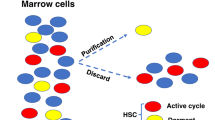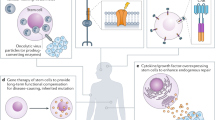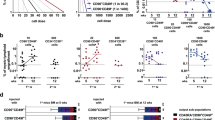Abstract
We report here that cells co-purifying with mesenchymal stem cells—termed here multipotent adult progenitor cells or MAPCs—differentiate, at the single cell level, not only into mesenchymal cells, but also cells with visceral mesoderm, neuroectoderm and endoderm characteristics in vitro. When injected into an early blastocyst, single MAPCs contribute to most, if not all, somatic cell types. On transplantation into a non-irradiated host, MAPCs engraft and differentiate to the haematopoietic lineage, in addition to the epithelium of liver, lung and gut. Engraftment in the haematopoietic system as well as the gastrointestinal tract is increased when MAPCs are transplanted in a minimally irradiated host. As MAPCs proliferate extensively without obvious senescence or loss of differentiation potential, they may be an ideal cell source for therapy of inherited or degenerative diseases.
This is a preview of subscription content, access via your institution
Access options
Subscribe to this journal
Receive 51 print issues and online access
$199.00 per year
only $3.90 per issue
Buy this article
- Purchase on Springer Link
- Instant access to full article PDF
Prices may be subject to local taxes which are calculated during checkout






Similar content being viewed by others
References
Thomson, J. A. et al. Embryonic stem cell lines derived from human blastocysts. Science 282, 1145–1147 (1998)
Frankel, M. S. In search of stem cell policy. Science 298, 1397 (2000)
Weissman, I. L. Translating stem and progenitor cell biology to the clinic: barriers and opportunities. Science 287, 1442–1446 (2000)
Gage, F. H. Mammalian neural stem cells. Science 287, 1433–1438 (2000)
Potten, C. Stem cells in gastrointestinal epithelium: numbers, characteristics and death. Phil. Trans R. Soc. Lond. B 353, 821–830 (1998)
Watt, F. Epidermal stem cells: markers patterning and the control of stem cell fate. Phil. Trans. R. Soc. Lond. B 353, 831 (1997)
Alison, M. & Sarraf, C. Hepatic stem cells. J. Hepatol. 29, 678–683 (1998)
Pittenger, M. F. et al. Multilineage potential of adult human mesenchymal stem cells. Science 284, 143–147 (1999)
Ferrari, G. et al. Muscle regeneration by bone marrow-derived myogenic progenitors. Science 279, 528–530 (1998)
Gussoni, E. et al. Dystrophin expression in the mdx mouse restored by stem cell transplantation. Nature 401, 390–394 (1999)
Orlic, D. et al. Bone marrow cells regenerate infarcted myocardium. Nature 410, 701–705 (2001)
Jackson, K. et al. Regeneration of ischemic cardiac muscle and vascular endothelium by adult stem cells. J. Clin. Invest. 107, 1395–1402 (2001)
Lin, Y., Weisdorf, D. J., Solovey, A. & Hebbel, R. P. Origins of circulating endothelial cells and endothelial outgrowth from blood. J. Clin. Invest. 105, 71–77 (2000)
Asahara, T. et al. Bone marrow origin of endothelial progenitor cells responsible for postnatal vasculogenesis in physiological and pathological neovascularization. Circ. Res. 85, 221–228 (1999)
Petersen, B. E. et al. Bone marrow as a potential source of hepatic oval cells. Science 284, 1168–1170 (1999)
Theise, N. D. et al. Derivation of hepatocytes from bone marrow cells in mice after radiation-induced myeloablation. Hepatology 31, 235–240 (2000)
Lagasse, E. et al. Purified hematopoietic stem cells can differentiate into hepatocytes in vivo. Nature Med. 6, 1229–1234 (2000)
Krause, D. S. et al. Multi-organ, multi-lineage engraftment by a single bone marrow-derived stem cell. Cell 105, 369–377 (2001)
Brazelton, T. R., Rossi, F. M. V., Keshet, G. I. & Blau, H. E. From marrow to brain: expression of neuronal phenotypes in adult mice. Science 290, 1775–1779 (2000)
Kopen, G., Prockop, D. & Phinney, D. Marrow stromal cells migrate throughout forebrain and cerebellum, and they differentiate into astrocytes after injection into neonatal mouse brains. Proc. Natl Acad. Sci. USA 96, 10711–10716 (1999)
Mezey, E., Chandross, K. J., Harta, G., Maki, R. A. & McKercher, S. R. Turning blood into brain: cells bearing neuronal antigens generated in vivo from bone marrow. Science 290, 1779–1782 (2000)
Sanchez-Ramos, J. et al. Adult bone marrow stromal cells differentiate into neural cells in vitro. Exp. Neurol. 164, 247–256 (2000)
Bjornson, C., Rietze, R., Reynolds, B., Magli, M. & Vescovi, A. Turning brain into blood: a hematopoietic fate adopted by adult neural stem cells in vivo. Science 283, 354–357 (1999)
Morshead, C. M., Benveniste, P., Iscove, N. N. & van der Kooy, D. Hematopoietic competence is a rare property of neural stem cells that may depend on genetic and epigenetic alterations. Nature Med. 8, 268–273 (2002)
Jackson, K., Mi, T. & Goodell, M. A. Hematopoietic potential of stem cells isolated from murine skeletal muscle. Proc. Natl Acad. Sci. USA 96, 14482–14486 (1999)
Kawada, H. & Ogawa, M. Bone marrow origin of hematopoietic progenitors and stem cells in murine muscle. Blood 98, 2008–2013 (2001)
Clarke, D. L. et al. Generalized potential of adult neural stem cells. Science 288, 1660–1663 (2000)
Reyes, M. et al. Purification and ex vivo expansion of postnatal human marrow mesodermal progenitor cells. Blood 98, 2615–2625 (2001)
Reyes, M. et al. Origin of endothelial progenitors in human post-natal bone marrow. J. Clin. Invest. 109, 337–346 (2002)
Schwartz, R. E. et al. Multipotent adult progenitor cells from bone marrow differentiate into functional hepatocyte-like cells. J. Clin. Invest. 109, 1291–1302 (2002)
Odorico, J. S., Kaufman, D. S. & Thomson, J. A. Multilineage differentiation from human embryonic stem cell lines. Stem Cells 19, 193–204 (2001)
Williams, R. L. et al. Myeloid leukaemia inhibitory factor maintains the developmental potential of embryonic stem cells. Nature 336, 684–687 (1988)
Scholer, H. R., Hatzopoulos, A. K., Balling, R., Suzuki, N. & Gruss, P. A family of octamer-specific proteins present during mouse embryogenesis: evidence for germline-specific expression of an Oct factor. EMBO J. 8, 2543–2550 (1989)
Ben-Shushan, E., Thompson, J. R., Gudas, L. J. & Bergman, Y. Rex-1, a gene encoding a transcription factor expressed in the early embryo, is regulated via Oct-3/4 and Oct-6 binding to an octamer site and a novel protein, Rox-1, binding to an adjacent site. Mol. Cell Biol. 18, 1866–1878 (1998)
Jordan, C., McKearn, J. & Lemischka, I. Cellular and developmental properties of fetal hematopoietic stem cells. Cell 61, 953–963 (1990)
Nolta, J., Dao, M., Wells, S., Smogorzewska, E. & Kohn, D. Transduction of pluripotent human hematopoietic stem cells demonstrated by clonal analysis after engraftment in immune-deficient mice. Proc. Natl Acad. Sci USA 93, 2414–2419 (1996)
Lenvik, T., Lund, T. C. & Verfaillie, C. M. Blockerette-ligated capture T7 amplified RT-PCR, a new method for determining flanking sequences. Mol. Therapy (in the press)
Palmer, T. D., Markakis, E. A., Willhoite, A. R., Safar, F. & Gage, F. H. Fibroblast growth factor-2 activates a latent neurogenic program in neural stem cells from diverse regions of the adult CNS. J. Neurosci. 19, 8487–8497 (1999)
Lee, S. H., Lumelsky, N., Studer, L., Auerbach, J. M. & McKay, R. D. Efficient generation of midbrain and hindbrain neurons from mouse embryonic stem cells. Nature Biotechnol. 18, 675–679 (2000)
Zambrowicz, B. P. et al. Disruption of overlapping transcripts in the ROSA beta geo 26 gene trap strain leads to widespread expression of beta-galactosidase in mouse embryos and hematopoietic cells. Proc. Natl Acad. Sci. USA 94, 3789–3794 (1997)
Reinhardt, R. L., Khoruts, A., Merica, R., Zell, T. & Jenkins, M. K. Visualizing the generation of memory CD4 T cells in the whole body. Nature 401, 101–105 (2001)
Weiss, M. J. & Orkin, S. H. GATA transcription factors: key regulators of hematopoiesis. Exp. Hematol. 23, 99–107 (1995)
Prochazka, M., Gaskins, H. R., Shultz, L. D. & Leiter, E. H. The nonobese diabetic scid mouse: model for spontaneous thymomagenesis associated with immunodeficiency. Proc. Natl Acad. Sci. USA 89, 3290–3294 (1992)
Anderson, D. J., Gage, F. H. & Weissman, I. L. Can stem cells cross lineage boundaries? Nature Med. 7, 393–395 (2001)
Terada, N. et al. Bone marrow cells adopt the phenotype of other cells by spontaneous cell fusion. Nature 416, 542–545 (2002); advance online publication, 13 March 2002 (doi:10.1038/nature00730)
Ying, Q. Y., Nichols, J., Evans, E. P. & Smith, A. G. Changing potency by spontaneous fusion. Nature 416, 545–548 (2002); advance online publication, 13 March 2002 (doi:10.1038/nature729)
Rideout, W. M. et al. Generation of mice from wild-type and targeted ES cells by nuclear cloning. Nature Genet. 24, 109–110 (2000)
Wilmut, I., Schnieke, A. E., McWhir, J., Kind, A. J. & Campbell, K. H. Viable offspring derived from fetal and adult mammalian cells. Nature 385, 810–813 (1997)
Pear, W. S. et al. Efficient and rapid induction of a chronic myelogenous leukemia-like myeloproliferative disease in mice receiving P210 bcr/abl-transduced bone marrow. Blood 92, 3780–3792 (1998)
Acknowledgements
The authors wish to thank M. Jenkins for technical support. This work was supported by NIH grants, the Michael J. Fox Foundation, the Children's Cancer Research Fund, the Tulloch Family Foundation, and the McKnight Foundation. R.E.S., C.D.K., X.R.O.-G. and M.R. are supported by the NIH-MSTP programme at the University of Minnesota.
Author information
Authors and Affiliations
Ethics declarations
Competing interests
C.M.V. is a consultant for MCL low liability company, Minneapolis.
Rights and permissions
About this article
Cite this article
Jiang, Y., Jahagirdar, B., Reinhardt, R. et al. Pluripotency of mesenchymal stem cells derived from adult marrow. Nature 418, 41–49 (2002). https://doi.org/10.1038/nature00870
Received:
Accepted:
Published:
Issue Date:
DOI: https://doi.org/10.1038/nature00870
This article is cited by
-
Priming and Combined Strategies for the Application of Mesenchymal Stem Cells in Ischemic Stroke: A Promising Approach
Molecular Neurobiology (2024)
-
Top Five Stories of the Cellular Landscape and Therapies of Atherosclerosis: Current Knowledge and Future Perspectives
Current Medical Science (2024)
-
Efficient delivery of mesenchymal stem/stromal cells to injured liver by surface PEGylation
Stem Cell Research & Therapy (2023)
-
Local transplantation of mesenchymal stem cells improves encephalo-myo-synangiosis-mediated collateral neovascularization in chronic brain ischemia
Stem Cell Research & Therapy (2023)
-
All-in-one smart dressing for simultaneous angiogenesis and neural regeneration
Journal of Nanobiotechnology (2023)
Comments
By submitting a comment you agree to abide by our Terms and Community Guidelines. If you find something abusive or that does not comply with our terms or guidelines please flag it as inappropriate.



